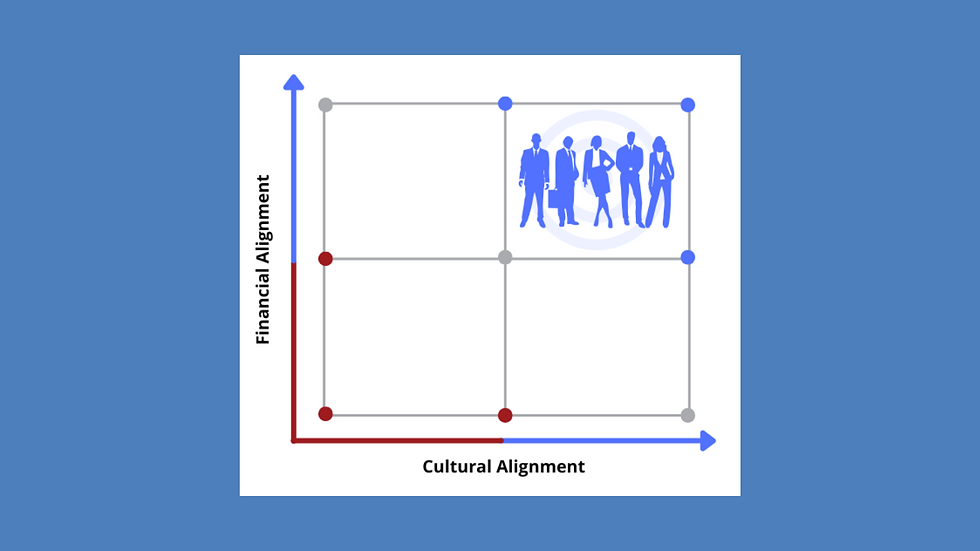Identifying and Understanding the Key Stakeholders in Your Blue Chip Clients
- Scott Peterson
- Sep 4
- 3 min read
Updated: Sep 15

You’ve been there:
A deal dies at the eleventh hour thanks to a stakeholder you didn’t even know existed.
Another drags on endlessly, stuck in the “friend-zone.”
Or your emails go unanswered, never sparking enough interest to even start a conversation.
It’s frustrating—but it’s not random. It’s the direct result of not fully understanding the buying group and the key stakeholders within it.
The work begins by getting tight and refined on your Blue Chip client profile. Once that foundation is set, the next step is diving deeper—understanding the individual stakeholders inside those clients who actually drive decisions.
From a Sales Process Standpoint — Identifying the Buying Group
The first step is getting crystal clear on who is part of the buying journey and when they need to be engaged.
Who to initiate with?
The likelihood of winning a deal changes dramatically depending on who you start with. The “right” stakeholder differs from company to company—which is why retrospectives and reviewing historical data matter. Starting with the wrong stakeholder decreases your chances of winning from the very beginning.
Who to include?
Similarly, your odds of winning hinge on if and when the right stakeholders are involved. If a key stakeholder is missing at discovery but shows up at proposal, chances are your solution will miss the mark. And if they’re absent all along but appear at the decision stage—brace yourself, because the chances of winning just plummeted.
From a Sales Management Standpoint — Ensuring Stakeholder Involvement
In weekly sales meetings, as you work through in-process opportunities in your CRM, you should be reviewing stakeholder involvement at each stage. Who’s in discovery? Who’s engaged at proposal? Who’s missing entirely?
Because if the right people aren’t in the room, the odds of success plummet.
From a Sales Strategy Standpoint — Understanding the Stakeholders
Once you’ve mapped who needs to be involved and when, the deeper work begins: truly understanding each stakeholder’s world.
Stakeholders come to the table from very different angles. For example, an Executive Leader may care most about growth and market position. An Operational Leader is focused on efficiency and execution. A Financial Leader looks at budgets, ROI, and risk. Each has their own agenda—and their own definition of success.
They don’t view priorities through the same lens. Which is why, as sellers, our job begins with understanding what matters most to each stakeholder. Only then can we bring them together—to agree on the problem first, and align on the solution second.
That’s where the Stakeholder Persona Canvas comes in. Unlike broad marketing personas that focus on demographics like where someone lives or what they drive, these personas are built specifically for sales—anchored to how stakeholders connect to your products, services, and the value you deliver.
Priorities — What sits at the very top of their plate?
Performance Measures — How is their success measured? What’s on their scorecard?
Problems — What obstacles or frustrations stand in their way?
Positive Outcomes — What wins or results are they seeking?
By putting yourself in their shoes, you gain the perspective needed to unify the buying group around shared priorities. That’s the difference between pushing your agenda and advancing theirs.
Why This Matters
Ignoring this step is why so many deals stall or die in “no decision.” And yet, I see far too many organizations gloss over it.
They’ll say, “Yeah, we know our stakeholders,” but don’t go deep enough. Or they underestimate the influence of supporting stakeholders—the so-called “influencers” who don’t sign contracts but absolutely shape outcomes.
According to CEB and The Jolt Effect, between 40–60% of opportunities end in no decision.
Understanding the who (the buying group) and the what (their 4 P’s) isn’t optional—it’s part of the foundation of an effective sales process and strategy. Done right, it’s what turns stalled deals into signed ones.
Revenue Compass Assessment
Identifying and understanding your key stakeholders is critical—but it’s only one part of the bigger picture.
In less than 5 minutes, the Revenue Compass Assessment will give you a clear diagnostic of your sales organization, including:
Where you’re strong in engaging the right stakeholders.
Where you may be missing critical voices in the buying group.
How you stack up across strategy, process, structure, and management.
Most importantly, it gives you and your team a shared framework—so you stop relying on gut feel about “who matters” in a deal and start basing decisions on facts.
Go Deeper
If this article on the 4 P’s of stakeholders resonated, you may also find these posts valuable:
Carver Peterson helps growth-minded leaders and organizations achieve predictable and sustainable revenue growth through a refined strategy, defined process and aligned structure.




Comments